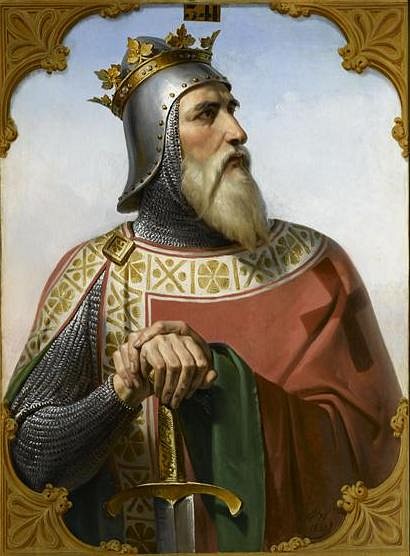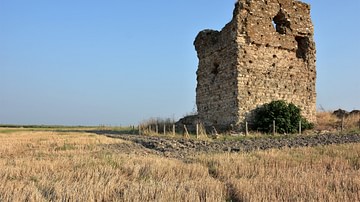The Battle of Civitate was fought in southeastern Italy on 18 June 1053 between a papal army of Pope Leo IX (r. 1049-1054) and an outnumbered force of Norman knights seeking recognition of their conquests and titles. The Normans were victorious, and 37 years after their arrival, the Norman conquest of Southern Italy could begin in earnest.

Southern Italy in 1000
Southern Italy in the 11th century was not united politically, rather it was a mélange of competing independent powers, often at odds with one another and all seeking their own ends. First, the remains of an old Lombard kingdom still existed through three competing principalities of Salerno, Capua, and Benevento. These principalities often shifted allegiance for and against one another as best suited them, recognizing the Byzantine emperor, the Holy Roman Emperor, or the Pope as circumstances became advantageous. Next, the western coastal cities of Naples, Amalfi, and Gaeta were wealthy trading entrepôts that nominally acknowledged the Byzantine emperor, though they were virtually independent. Furthermore, most of Southern Italy including the modern-day provinces of Apulia and Calabria were claimed by the Byzantine Empire, though they were often unable to govern these far-off lands effectively, especially after 1025. Heavy taxation and military conscription embittered the local populace frequently causing revolts against Byzantine rule.
Another problem to contend with was the old Byzantine province of Sicily, which had fallen to a North African Islamic power in the 9th century. Naval raiding parties were frequently sent out from Sicilian ports against nearby Italian coastal cities. Lastly, the Papal States to the north of Byzantine and Lombard lands were nominally led by the Catholic Pope and theoretically backed by the armies of the Holy Roman Emperor, who claimed sovereignty over the entirety of the peninsula without much ability to exercise such claims.

It was into this confusing quagmire that the Normans stepped around 1017, principally as mercenaries. Skilled warriors, Normans began training in horsemanship, hunting, and outdoor survival skills at an early age. Their military discipline, armor, and ability to fight in group formations from horseback made them capable fighters. They had also perfected the use of the massed cavalry charge often sweeping all before them and earning them a fearsome reputation. Ironically though, it seems to have been their Christian faith and piety, which initially brought them south.
Lombard Dissidents
On the slopes of Mount Gargano in southeastern Italy exists a shrine to the Archangel Michael, which was especially revered by Norman pilgrims. A group of roughly 40 Norman knights was visiting the shrine in 1016 when they met a Lombard dissident named Melus who asked for their help in ridding his city of Bari from Byzantine rule.

The combination of heavy taxation and compulsory military service in Byzantine lands would often cause the enmity of local Lombard lords, sometimes leading to open revolt. Such had happened in 1009 when Melus and his brother-in-law took possession of Bari and a few nearby cities. Within a few years, the Byzantines had reclaimed their cities, forcing Melus to flee to Salerno to contemplate his next move. When this band of Norman pilgrims encountered Melus in 1016, they dutifully agreed to help Melus after returning home for reinforcements, thus beginning the Norman presence in Southern Italy.
Rainulf & the First Normans in Italy
Melus and his Norman allies initially lost against a stronger Byzantine force in 1018, however, Byzantine strength in Italy would be hampered by the loss of Emperor Basil II (r. 975-1025) in 1025, resulting in nearly a half-century of weak Byzantine emperors. Certain Lombard leaders noticed the change in Byzantine foreign policy and recruited these new Norman mercenaries. For instance, the Prince of Capua, Pandulf IV, sought to exploit Byzantine weakness by attacking the neighboring cities of Naples and Gaeta. Without strong Byzantine reprisal, Pandulf could use his Norman allies to bully his neighbors into submission.
The leading Norman figure in these early stages was one Rainulf Drengot (d. 1045). Though initially allied to Pandulf, he switched sides around 1029, earning the gratitude of Sergius IV, the Duke of Naples. As a reward, Sergius offered Rainulf the town of Aversa in 1030, along with a marriage proposal to his own sister. In an instant, Rainulf gained his own fief, became brother-in-law to a Duke, and was inducted into the aristocracy of Southern Italy.
Aversa was situated between Capua and Naples, providing Rainulf with the ability to tip the balance of power to whomever he supported. When Rainulf's wife died, he married Pandulf's niece in 1035, switching allegiance back to Pandulf of Capua. By 1038, Rainulf switched sides again, now supporting Guimar IV (r. 1027-1052), Prince of Salerno, after Pandulf earned the wrath of everyone by raiding the nearby abbey of Monte Cassino.
Guimar and Rainulf actually joined with Conrad II, Holy Roman Emperor (r. 1032-1039), in 1038 to arrest Pandulf for his crimes, and in so doing, Rainulf was formally invested with imperial recognition as the Count of Aversa by Conrad. Through shrewd political adroitness and shifting allegiances, Rainulf managed to become a leading military figure in southwest Italy barely 20 years after his arrival.

The Hautevilles
Rainulf's success inevitably attracted more Norman recruits in search of their own wealth and fame. The Hauteville family would come to play an important role in Italy, due mainly to the fertility of their patriarch, and the modesty of his estate, unable as it was to support his many sons. Tancred de Hauteville (980-1041) sired twelve sons by two women during his lifetime, and in 1035, the three oldest sons, William (1005-1046), Drogo (1010-1051), and Humphrey (1010-1057) made their way south to join Rainulf's growing army. A few years after arriving, the Hauteville brothers elected to join a Byzantine expedition to reclaim Sicily in 1038, where William distinguished himself in battle by unhorsing the Emir of Syracuse during a siege. William's act of bravado won him the sobriquet 'Iron Arm' and recognition from his peers as a military leader. The Byzantine army broke up soon after, though the Hautevilles had no trouble finding additional work back in Italy. Upon returning to Salerno, the brothers found that an insurrection against Byzantine rule had erupted in Apulia.
By 1040, a Lombard noble named Arduin with a group of Normans including the Hauteville brothers was granted control of Melfi, an important hilltop fortress halfway between Salerno and Bari. From Melfi, Lombard, and Norman forces won a series of victories over the Byzantines. Through his own prowess and force of personality, William de Hauteville was eventually elected by his peers as the leader of Norman forces in Apulia in 1042. However, feudal custom required that a formal title be granted from an appropriate source, like a prince, duke, or emperor. The Lombard prince, Guimar IV of Salerno obliged William's request, and in 1042, William was proclaimed Count of Apulia under Guimar, solidifying a second focal point of Norman power in Southern Italy.
The Road to Civitate
The two poles of Norman power established at Melfi and Aversa had been strengthened by official investiture from Henry III, Holy Roman Emperor (r. 1046-1056), in 1047. However, unused to ruling, Norman lords quickly gained a reputation for brigandage and heavy-handedness against those they were supposed to be protecting. Furthermore, many Norman lords were spreading out across Apulia, and although William, then Drogo, and then Humphrey were nominally their overlords, the Hauteville brothers exercised little control over their independent countrymen. This became a problem in 1051 when the nearby Papal Duchy of Benevento suffered from Norman raids, attracting the unwelcome attention of Pope Leo IX (r. 1049-1054).
Leo was concerned about Norman expansion, so he formed an alliance with a local Byzantine lord under the presumption that the Normans represented the largest threat to Southern Italy. Having no standing army of his own, Leo turned to Emperor Henry III to send troops, though the emperor could spare just a small but dangerous detachment of Swabian swordsmen. Leo marched these men south, acquiring volunteers along the way until he had amassed a considerable force. The plan was to link up with the army of his Byzantine ally, then together they would confront the Normans.
The Norman barons for their part were aware of their predicament, facing papal, Byzantine, and local Apulian forces. Outnumbered as they were, they understood the need to work together. Therefore, the new ruler of Aversa, Richard II, Count Humphrey of Apulia, and Robert Guiscard (the oldest son of Tancred's second marriage) joined together in an effort to prevent papal forces from linking up with the Byzantines. 17 June 1053 found the Norman knights facing the papal army outside the town of Civitate, near modern-day San Severo within sight of the River Fortore.
Talks began with Leo hoping to stall until the Byzantine army arrived, while the Normans appear to have had genuine misgivings about attacking God's chosen representative on earth. Even so, the Normans were aware of the approaching Byzantines, which would weaken their position dramatically. Talks seem to have broken down with the German swordsmen jeering at the Normans, and encouraging Leo to reject their overtures of peace. The battle commenced the next morning.
The Battle
The papal army may have numbered as many as 6,000 infantry and horsemen. The left flank was composed of various Lombard and Italian allies, while the German swordsmen commanded the right and center in a thin line. The Swabian swordsmen were the backbone of this force, fierce fighters preferring death to surrender. William of Apulia, a contemporary source favorable to the Normans describes the German fighters in some detail:
The German people were accompanied by numerous allies, and trusted (wrongly) in the help of the cowardly Lombards…There were proud people of great courage, but not versed in horsemanship, who fought rather with the sword than with the lance…These swords were very long and keen, and they were often capable of cutting someone vertically in two! They preferred to dismount and take guard on foot, and they chose rather to die than to turn tail. Such was their bravery that they were far more formidable like this than when riding on horseback. (20)
Comparatively, the outnumbered Normans may have had roughly 3000 horsemen and 500 infantry, split into three groups, with Richard of Aversa and his mounted knights on the right flank facing the Lombards. Count Humphrey appears to have led the infantry and archers in the center facing the Germans, while Robert led his own mounted troops on the left flank, and was to be held in reserve, helping where it was most needed.
The battle opened with a charge from Richard of Aversa, who appears to have scattered the Italian and Lombard soldiers at first contact. With the left flank of the papal army already on the run, the Germans faced off against Humphrey's infantry. William of Apulia describes the scene:
The Swabians drew up their line of battle against the arms of the valiant Humphrey. First Humphrey attacked them at long-range with arrows, he in turn was harried by the arrows of his enemies. Finally both sides charged sword in hand, and their swords inflicted some incredible blows on each other; you could see human bodies split down the middle,and horse and man laying dead together. Then Robert, seeing his brother so fiercely attacked by enemies resolved to yield not an inch, charged fiercely and proudly into the midst of the hostile ranks… He was unhorsed three times, thrice he recovered his strength and returned more fiercely to the fray. (21)
The battle against the Germans was fierce and almost turned against the Normans. What saved the day was the discipline of Richard of Aversa and his knights, who returned from routing the Italians, and flanked the Germans from a third side. William concludes the battle for us in the following lines:
The glorious army of Richard the victorious joining them was the primary cause of their enemies' catastrophe. The unhappy men perished in various ways, and of all these men not one survived. (22)
Aftermath
Pope Leo was humiliated, his army routed, with his German contingent slaughtered to a man. Surprisingly, the victorious Normans did not behave as though they had captured an enemy but are said to have fallen to their knees, begging Leo's forgiveness and even escorting him back to the papal city of Benevento. Regardless of the professed Norman piety, Leo was held as a virtual prisoner in the city for nearly a year. He was allowed to conduct the affairs of his office, though not permitted to leave until he agreed to formally confirm the Normans in all the lands they had seized to date.
After roughly nine months of captivity, Leo seems to have agreed to terms, recognizing Norman conquests up to the present time. With no further reason to keep him bottled up in Benevento, Leo was permitted to leave on 12 March 1054, escorted by Count Humphrey as far as Capua on his way to Rome.
The Significance of Civitate
The Normans had achieved their greatest victory since arriving in Southern Italy 37 years earlier. They had gained formal papal recognition of their right to the lands they had conquered, and they had shown that they were too powerful to be eradicated.
The Battle of Civitate was a turning point for the Normans, after which their conquest of Southern Italy and Sicily could really begin. Robert Guiscard assumed control after Humphrey's death c. 1057, and he began to wrest power away from existing Lombard, Byzantine, and papal influence. Just two years later, the new Pope, Nicholas II (r. 1059-1061) would ceremonially invest Robert as the Duke of Apulia, Calabria, and Sicily through the Treaty of Melfi. The historian Susan-Wise Bauer explains the significance of this treaty further in the following passage:
But the Treaty of Melfi did much more. It renounced the special right of the "Roman Emperor" to protect the heirs of St. Peter. In signing it, Nicholas II took away the central duty that made the office of the emperor holy. That duty had now been handed over to the Normans, who—as part of the treaty—even promised they would fight for the pope, and against any future Holy Roman Emperor, if necessary. (594)
This was perhaps the most significant outcome of Civitate, in that the papacy now saw the Normans, not the Holy Roman Emperor as best able to protect them and their interests in Italy, ultimately, influencing the balance of power in the region. Recognized by the papacy as the legal lord of his vast domains, Robert could begin the process of unifying all of Southern Italy under him and his heirs.
A gifted military commander, Robert eventually established a modicum of control over his vast Apulian and Calabrian dominions, despite constant revolts from his barons. Furthermore, he and his younger brother Roger I began the process of reconquering Sicily. Robert even managed to invade the Byzantine Empire itself with some success. Robert's nephew, Roger II (r. 1105-1154) managed to coalesce these vast realms into a wealthy and efficient kingdom based in Palermo by 1130, thanks in part to the foundations laid out by his forebears at the Battle of Civitate.












